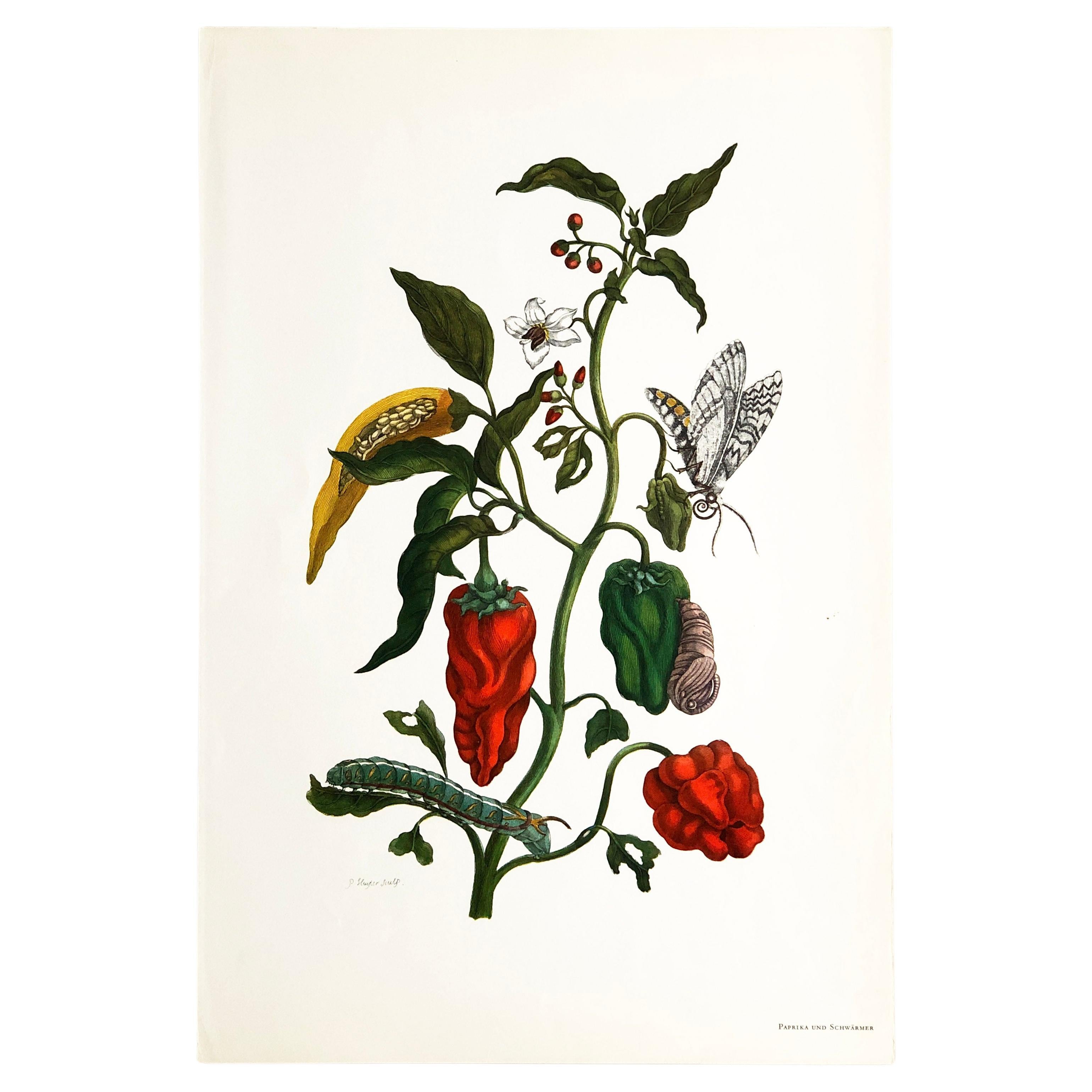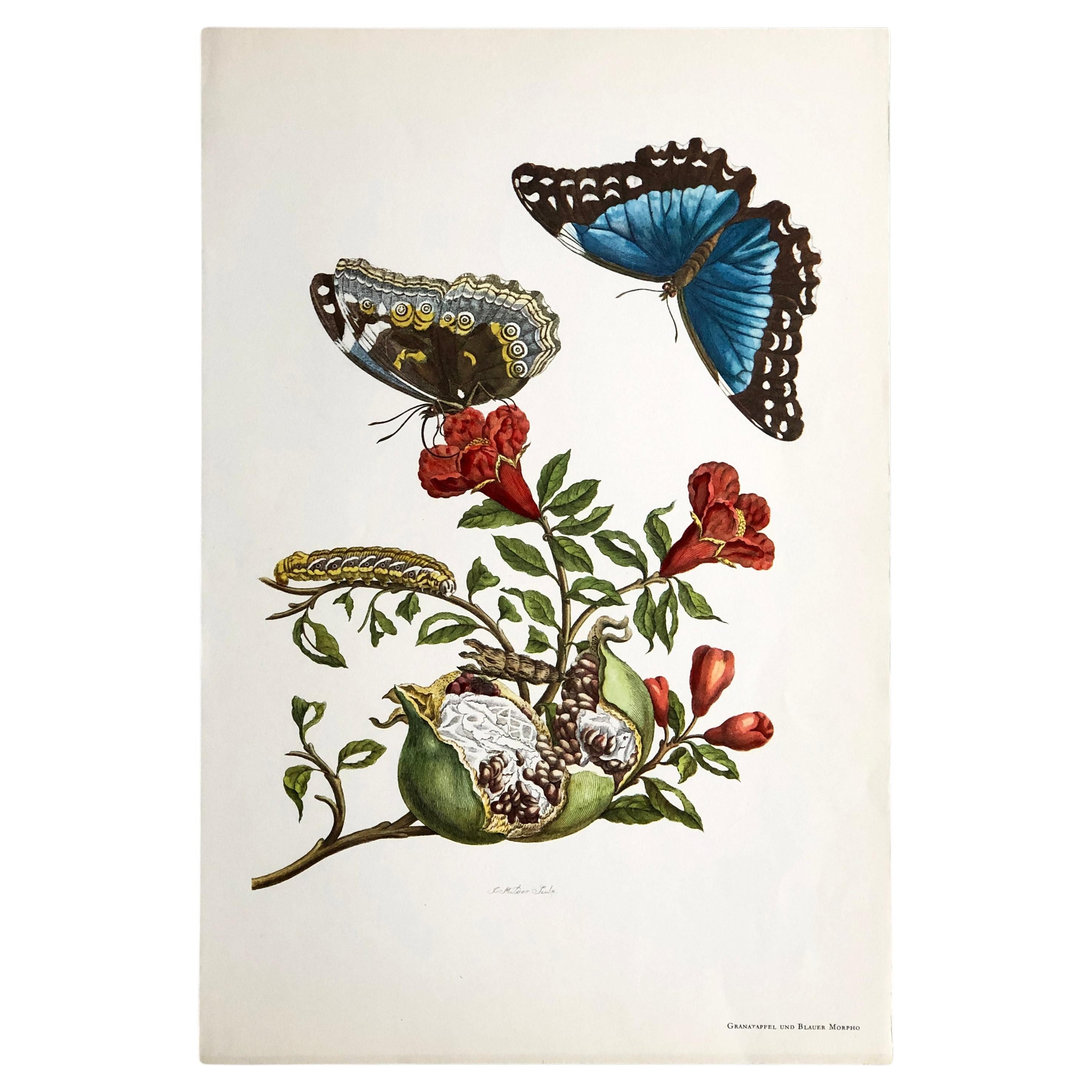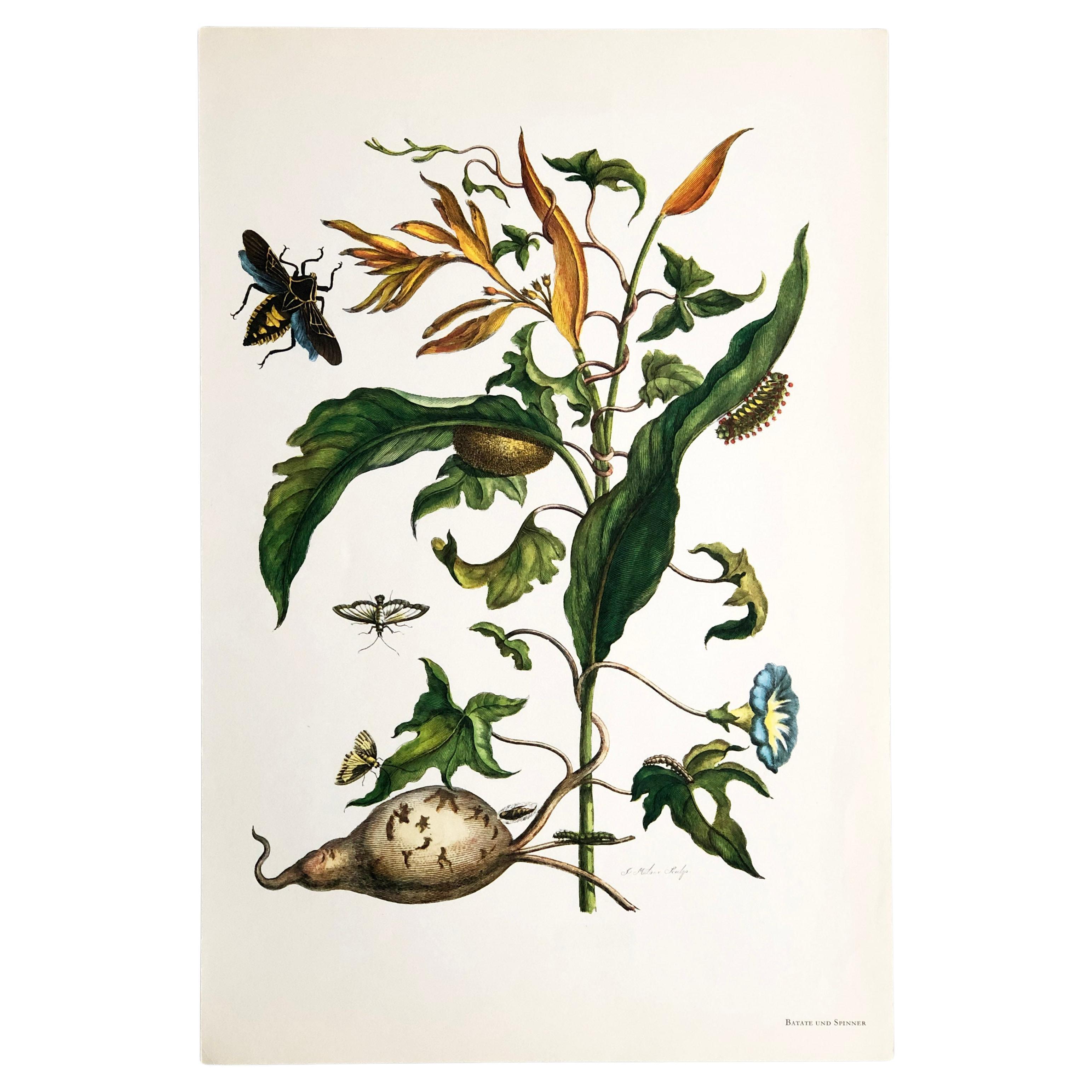Items Similar to Emanuel Sweert - Maria Merian - Daniel Rabel - Copper engraving 4 tulips plate 5
Video Loading
Want more images or videos?
Request additional images or videos from the seller
1 of 22
Emanuel Sweert - Maria Merian - Daniel Rabel - Copper engraving 4 tulips plate 5
About the Item
ONE OF THE MOST BEAUTIFUL TULIP ENGRAVINGS EVER PUBLISHED Four Tulips PL.V. (plate 5), copper engraving made by Em(m)anuel Sweert(s) and published by Daniel Rabel in Paris 1622-1633 as part of the "Theatrum Florae", coloured/painted later by hand.
This work comes from the collection of the famous Berlin gallerist Eleonore Halbscheffel (Germany). Gallerie DER KUPFERTICH specialized in copper engravings from the 17th and 18th centuries.
See the images of the gallery's old advertisements from the 1940s.
It's in the original gold frame with passe partout with inlaid gold striping.
Description on back: Tulips - blossom
Original copperplate engraving by Maria-Sibylla Marian from around 1720.
Specimen of particular beauty.
Measurements with frame:
Width 52 cm / 20,47 inch
Height 66,5 cm / 26,18 inch
Measurements Artwork / inside passe partout:
Width 28 cm / 11,02 inch
Height 41 cm / 16,14 inch
Four tulips PL.V. (plate 5), copper engraving made by Em(m)anuel Sweert(s) and published by Daniel Rabel in Paris 1622-1633 as part of the "Theatrum Florae", coloured in later by hand. Daniel Rabel (1578-1637) was first employed as a portrait painter by Marie de Medicis, the second wife of Henry IV of France. In 1612 he became official artist to Duke of Nevers. Around 1631 he was appointed official artist to Gaston, Duke of Orléans, Henry IV's third son. The "Theatrum Florae" was originally published in Paris in 1622, with later editions in 1627 and 1633, and was a collection of botanical illustrations of 69 of the most decorative flowers available to 17th-century gardeners, and which Rabel had been commissioned to paint for Gaston of Orléans. It is truly (as stated in the preface to vol.I) ".une tres-jolie collection qui ont été dessinées & gravées d'après nature" [.a very nice collection.which were drawn and engraved from nature]. Other artists later added their work, notably Nicolas Robert (1614 1685). There is some doubt among scholars as to whether Rabel engraved the original 69 plates, as none of them is signed and his name only appears on the titlepage of the third edition. By the end of the 1700s they were generally assumed to have been done by Dutch artist Emanuel Sweert.
Four tulips PL.V. (plate 5)
Image 11: Tulipa alba cum punctis et veniis flame rubentibus
Image 12: Tulipa alba coum punctis et flammis rubris serotina
Image 13: Tulipa flore albicante cum punctis et flammis purpureis unguibus atro purpureis sub albo circulo cinctis
Image 14: Tulipa Eyrizine aliis bonbicina flore rubro unguibus purpureis sulphureis circulo cinctis
This plate was a part of The bulb catalog of Emanuel Sweert, the very first bulb catalog in the world. The catalog was published in 1612. Constantijn Huygens used the catalog in the creation of his famous garden in Voorburg. Fortunately, we know exactly which bulbs were in circulation at the beginning of the 17th century, thanks to the bulb catalog of the Amsterdammer Emanuel Sweert.
Sweert had been the court gardener for Emperor Rudolf II in Vienna. He sold his bulbs in Amsterdam, at the bookstore of his son-in-law, and at the annual market in Frankfurt. In 1612, he released a catalog featuring all the bulbs in his possession, marking the world's very first bulb catalog. The illustrations were drawn and engraved by artists.
Tulips were actually the driver behind Europe's first ever commercial catalogue.
Although Amsterdam and Tulips now seem as synonymous as Holland and windmills, the flower is not originally Dutch. It reached the low countries in the late 16th century having traveled from Central Asia via Turkey and Vienna. Fortunately, the flower fit admirably with the spirit of the Dutch golden age and the associated craze for 'curiosities'. Initially, the Tulip was only cultivated with the assistance of gardeners employed by wealthy 'burghers', as they were the only ones able to afford a garden for pleasure. However, admiration for the flower began to expand beyond the upper class with the publication of books and manuals highlighting its unique beauty. Emanuel Sweert's Florilegium is perhaps the best known of those books. In fact, it is now believed to be the first commercial nursery catalog in Europe's history. In life, Emanuel Sweert was successful as both a botanist and a businessman. He lived primarily in Amsterdam on the Bloemgracht, a canal in one of the new layouts of the then rapidly expanding city. While not the first to have business in selling curiosities like shells, fossils, and bulbs; he ws the first to recognize the true commercial value of the Tulip.
His superbly hand-colored Florilegium of 1612 helped to broaden the potential market for Tulips. Magnificent garden Tulips appear in the book, feathered and flamed in gorgeous colors. Technology also played a key role in its popularity, as Sweert used engravings on copper plates (versus older woodblocks) in publication, allowing for much more detail to be captured.
Sweert used his catalog to whet his customers' appetites for his wares. In modern terms, they were point-of-sale materials or classy advertisements. But in the dark days of October and November, when bulbs went on sale, potential customers needed a vision of what was inside the brown, round bulbs, and Sweert's publication became a bestseller (including many reprints in the early 17th century).
- Creator:
- Dimensions:Height: 26.19 in (66.5 cm)Width: 20.48 in (52 cm)Depth: 0.6 in (1.5 cm)
- Style:Other (Of the Period)
- Materials and Techniques:
- Place of Origin:
- Period:
- Date of Manufacture:circa 1700
- Condition:Wear consistent with age and use.
- Seller Location:EINDHOVEN, NL
- Reference Number:1stDibs: LU9046238464802
About the Seller
5.0
Vetted Seller
These experienced sellers undergo a comprehensive evaluation by our team of in-house experts.
Established in 2009
1stDibs seller since 2023
8 sales on 1stDibs
Typical response time: 1 hour
- ShippingRetrieving quote...Ships From: EINDHOVEN, Netherlands
- Return PolicyA return for this item may be initiated within 10 days of delivery.
More From This SellerView All
- Maria Sibylla Merian - P. Sluyter - Peppers and Hawkmoths Nr. 55By Maria Sibylla MerianLocated in EINDHOVEN, NLFrom Metamorphosis Insectorum Surinamensium, first published 1705 Engravings by J. Mulder, P. Sluyter (Sluiter) and D. Stoopendaal after Maria Sybilla Merian. This plate is part of a comprehensive collection comprising 17 plates. Check out other listings to view the entire series. 1964 Hoffman and Campe Verlag, Hamburg Complete production Mladinska Knjiga, Ljubljana/Yugoslavia. This 1964 official reproduction table come from the editions: Dissertation sur la génération et les transformations des insectes de Surinam, The Hague, Pierre Gosse, 1726, and Over de Voortteeling en Wonderbaerlyke Veranderingen der Surinaamsche insects, Amsterdam, Jean Frederic Bernard, 1730. PEPPERS AND MOTIVES Paprika, from the night damage family, a gift from the New to the Old World, a pleasant one like tomatoes and potatoes, like corn and beans, not a dangerous one like tobacco. You can no longer imagine our, especially the Mediterranean cuisine of the pre-Columbian period, both received such enrichment from America, potatoes, corn, beans as substances, tomatoes and peppers as spices and flavors, foreign, from far away , adding a new dimension to our dishes. The pepper has become the strongest source of vitamins in our latitudes, an indispensable medicine in our often denatured food. The varieties we grow belong to the species Capsicum annuum, the plant drawn by the painter is Capsicum sinense, of which two or three fruit shapes and different stages of ripeness were combined on one branch. The ripe fruit bodies are visible on the eye of the tongue: anyone who looks at them will taste the peppery spiciness after a while. The leaf is a triangle, it thins from the lower broad solidity of the capsule area up to the lightness of the buds and flowers. Diversity also in the fact that the fruits are of different lengths, different colors, harmony between the dark green and red shapes, relief-like articulation of the pod surfaces. Butterfly, chrysalis and caterpillar cannot be precisely defined; they are hawkmoths from a group that counts seventy species in tropical America. A close relative of the strong-snouted Cocytius antarus - the pupa's beak is also noticeable here. (Original plate no. 55) ____________________________________ Maria Sibylla...Category
Antique 18th Century Dutch Other Prints
MaterialsPaper
- Maria Sibylla Merian - J. Mulder - Batate and spinners Nr.41By Maria Sibylla MerianLocated in EINDHOVEN, NLFrom Metamorphosis Insectorum Surinamensium, first published 1705 Engravings by J. Mulder, P. Sluyter (Sluiter) and D. Stoopenda...Category
Antique 18th Century Dutch Other Prints
MaterialsPaper
- Maria Sibylla Merian - J. Mulder - Passionflower and insects Nr. 21By Maria Sibylla MerianLocated in EINDHOVEN, NLFrom Metamorphosis Insectorum Surinamensium, first published 1705 Engravings by J. Mulder, P. Sluyter (Sluiter) and D. Stoopendaal after Maria Sybilla Merian. This plate is part of a comprehensive collection comprising 17 plates. Check out other listings to view the entire series. 1964 Hoffman and Campe Verlag, Hamburg Complete production Mladinska Knjiga, Ljubljana/Yugoslavia. This 1964 official reproduction table come from the editions: Dissertation sur la génération et les transformations des insectes de Surinam, The Hague, Pierre Gosse, 1726, and Over de Voortteeling en Wonderbaerlyke Veranderingen der Surinaamsche insects, Amsterdam, Jean Frederic Bernard, 1730. PASSION FLOWER AND INSECTS A leaf filled with life, a small cosmos, a square without a blank space, once again the dominance of the plant, Passiflora laurifolia, i.e. bay leaf passionflower, from the Passifloraceae family, beautiful the open flower that shines into the sun. As the English names Yellow Granadine and Jamaica Honeysuckle suggest, the juice of the fruit is made into drinks; the taste is so pleasant that the plant, which comes from America, has spread throughout the tropics. The author praises the pleasant, widely noticeable scent. On the stem at the bottom right and in the middle on the left are two colorful bugs, just like these rhynchotes, which we despise, make magnificent creatures in the tropics. The butterfly on the right is no more definable than all the caterpillars and pupae shown here. Two caterpillar sacks, houses of sack carriers, are shown. The caterpillars build this shell out of webs, stones, pieces of leaves and stems and carry it around with them like a hermit crab does its snail shell. When they want to move or eat, they leave it with only their front part and pull By closing the opening, they retreat inside in case of danger. (Original plate no. 21) ____________________________________ Maria Sibylla...Category
Antique 18th Century Dutch Other Prints
MaterialsPaper
- Maria Sibylla Merian - J. Mulder - Pomegranate and blue morpho Nr. 9By Maria Sibylla MerianLocated in EINDHOVEN, NLFrom Metamorphosis Insectorum Surinamensium, first published 1705 Engravings by J. Mulder, P. Sluyter (Sluiter) and D. Stoopendaal after Maria Sybilla Merian. This plate is part of ...Category
Antique 18th Century Dutch Other Prints
MaterialsPaper
- Maria Sibylla Merian - J. Mulder - Batate and spinners Nr. 41By Maria Sibylla MerianLocated in EINDHOVEN, NLFrom Metamorphosis Insectorum Surinamensium, first published 1705 Engravings by J. Mulder, P. Sluyter (Sluiter) and D. Stoopendaal after Maria Sybilla Merian. This plate is part of a comprehensive collection comprising 17 plates. Check out other listings to view the entire series. 1964 Hoffman and Campe Verlag, Hamburg Complete production Mladinska Knjiga, Ljubljana/Yugoslavia. This 1964 official reproduction table come from the editions: Dissertation sur la génération et les transformations des insectes de Surinam, The Hague, Pierre Gosse, 1726, and Over de Voortteeling en Wonderbaerlyke Veranderingen der Surinaamsche insects, Amsterdam, Jean Frederic Bernard, 1730. BATATE AND SPINNER A rich engraving, the diversity depicted is introduced by the unusual duality of the forage plants. The climbing plant with the blue morning glory flower and the underground tuber is in fact a convolvulaceae, the Ipomoea batatas, sweet potato or batate, which is widely grown in the tropics and subtropics. The yellow-flowered herb is a relative of bananas, a Heliconia, whose species could not be determined. The juxtaposition of the towering and twining growth, the lower, self-contracted tuber and the upper, bright, differentiated flower. A tropical bug flies towards the top left. At the top right is a spider caterpillar with a cocoon - an error on the part of the author that she let the bug emerge from the web. Below are two caterpillars, the pupa and two butterflies of a dioptid, a family of about five hundred similar species that inhabits America. Here too, definitions are only possible with anatomical examination, as the species imitate each other, predominantly with red-black markings. Maria Sibylla...Category
Antique 18th Century Dutch Other Prints
MaterialsPaper
- Maria Sibylla Merian - J. Mulder - Citron and longhorn beetle Nr. 28By Maria Sibylla MerianLocated in EINDHOVEN, NLFrom Metamorphosis Insectorum Surinamensium, first published 1705 Engravings by J. Mulder, P. Sluyter (Sluiter) and D. Stoopendaal after Maria Sybilla Merian. This plate is part of ...Category
Antique 18th Century Dutch Other Prints
MaterialsPaper
You May Also Like
- 2 Antique Framed Emanuel Sweert Florigriums Botanical Latin Plant EngravingsBy Emanuel SweertLocated in Dayton, OHPair of antique Emanuel Sweert Florilegium floral botany plant bulb engravings. Plates 32 and 67. 32. Pancralim orientals, pancratium occidentalis. 67. Narc. Promont. bona fpei...Category
Early 20th Century Prints
MaterialsPaper
- English Steel Plate Engraving of StreetscapeLocated in New York, NYEnglish Victorian steel plate engraving of a streetscape (19th-Century) in a black and gold decorative frame. Written on back of frame: (1856...Category
Antique 19th Century British Victorian Paintings
MaterialsGold, Steel
- English Steel Plate Engraving of a CathedralLocated in New York, NYEnglish Victorian steel plate engraving of an interior cathedral (19th-Century) in a black and gold decorative frame. Written on back of fram...Category
Antique 19th Century British Victorian Paintings
MaterialsGold, Steel
- Daniel Belliard Enamel on Copper Small Framed Painting Yellow CountrysideLocated in Philadelphia, PADaniel Belliard Enamel on Copper Small Framed Painting Yellow Countryside. Item features enamel on copper painting, wooden frame, artist signatu...Category
Late 20th Century Modern Paintings
MaterialsCopper, Enamel
- Sampson & Dalilah "At The Gate Of Prison" Colored Copper EngravingLocated in Kastrup, DKSampson & Dalilah, At the gate of prison. Colored copper engraving in contemporary Empire mahogany frame with internal line intarsia, gilt with ...Category
Antique Early 19th Century English Empire Paintings
MaterialsPaper
- Still Life with Fruits and Copper PlateLocated in Alessandria, PiemontePleasant French still life with fruits and copper plate, frame with little pomegranates relief - Signed low to the left - O/7133 - Dimensions: canvas cm. 87 x70 H. Frame cm. 102 x 8...Category
Antique Late 19th Century French Beaux Arts Paintings
MaterialsCanvas





